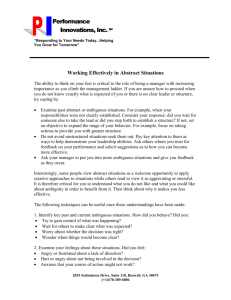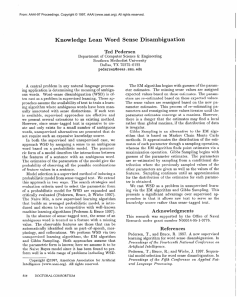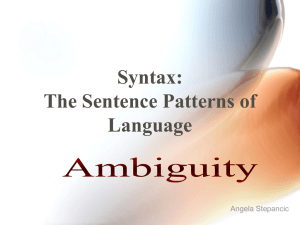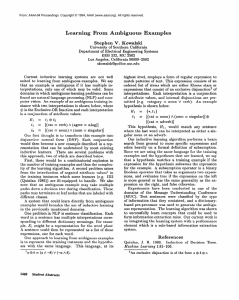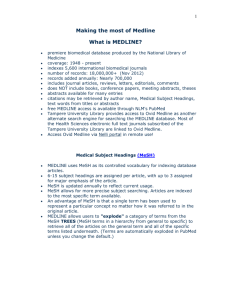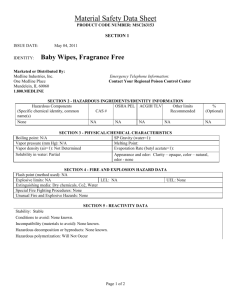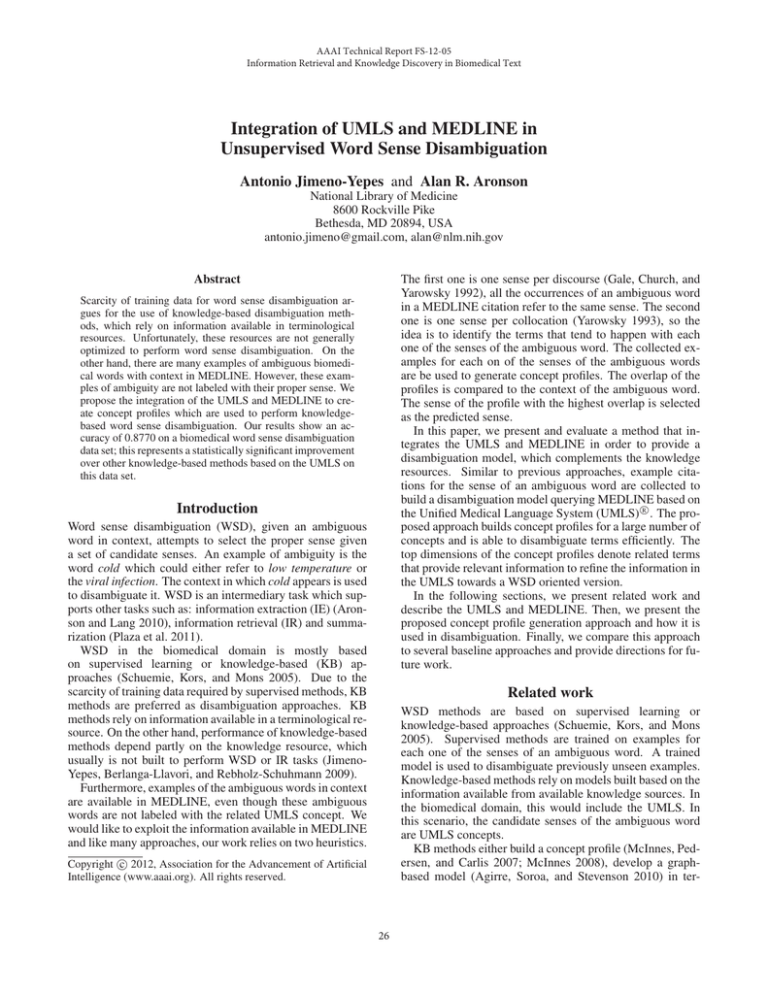
AAAI Technical Report FS-12-05
Information Retrieval and Knowledge Discovery in Biomedical Text
Integration of UMLS and MEDLINE in
Unsupervised Word Sense Disambiguation
Antonio Jimeno-Yepes and Alan R. Aronson
National Library of Medicine
8600 Rockville Pike
Bethesda, MD 20894, USA
antonio.jimeno@gmail.com, alan@nlm.nih.gov
Abstract
The first one is one sense per discourse (Gale, Church, and
Yarowsky 1992), all the occurrences of an ambiguous word
in a MEDLINE citation refer to the same sense. The second
one is one sense per collocation (Yarowsky 1993), so the
idea is to identify the terms that tend to happen with each
one of the senses of the ambiguous word. The collected examples for each on of the senses of the ambiguous words
are be used to generate concept profiles. The overlap of the
profiles is compared to the context of the ambiguous word.
The sense of the profile with the highest overlap is selected
as the predicted sense.
In this paper, we present and evaluate a method that integrates the UMLS and MEDLINE in order to provide a
disambiguation model, which complements the knowledge
resources. Similar to previous approaches, example citations for the sense of an ambiguous word are collected to
build a disambiguation model querying MEDLINE based on
R
the Unified Medical Language System (UMLS)
. The proposed approach builds concept profiles for a large number of
concepts and is able to disambiguate terms efficiently. The
top dimensions of the concept profiles denote related terms
that provide relevant information to refine the information in
the UMLS towards a WSD oriented version.
In the following sections, we present related work and
describe the UMLS and MEDLINE. Then, we present the
proposed concept profile generation approach and how it is
used in disambiguation. Finally, we compare this approach
to several baseline approaches and provide directions for future work.
Scarcity of training data for word sense disambiguation argues for the use of knowledge-based disambiguation methods, which rely on information available in terminological
resources. Unfortunately, these resources are not generally
optimized to perform word sense disambiguation. On the
other hand, there are many examples of ambiguous biomedical words with context in MEDLINE. However, these examples of ambiguity are not labeled with their proper sense. We
propose the integration of the UMLS and MEDLINE to create concept profiles which are used to perform knowledgebased word sense disambiguation. Our results show an accuracy of 0.8770 on a biomedical word sense disambiguation
data set; this represents a statistically significant improvement
over other knowledge-based methods based on the UMLS on
this data set.
Introduction
Word sense disambiguation (WSD), given an ambiguous
word in context, attempts to select the proper sense given
a set of candidate senses. An example of ambiguity is the
word cold which could either refer to low temperature or
the viral infection. The context in which cold appears is used
to disambiguate it. WSD is an intermediary task which supports other tasks such as: information extraction (IE) (Aronson and Lang 2010), information retrieval (IR) and summarization (Plaza et al. 2011).
WSD in the biomedical domain is mostly based
on supervised learning or knowledge-based (KB) approaches (Schuemie, Kors, and Mons 2005). Due to the
scarcity of training data required by supervised methods, KB
methods are preferred as disambiguation approaches. KB
methods rely on information available in a terminological resource. On the other hand, performance of knowledge-based
methods depend partly on the knowledge resource, which
usually is not built to perform WSD or IR tasks (JimenoYepes, Berlanga-Llavori, and Rebholz-Schuhmann 2009).
Furthermore, examples of the ambiguous words in context
are available in MEDLINE, even though these ambiguous
words are not labeled with the related UMLS concept. We
would like to exploit the information available in MEDLINE
and like many approaches, our work relies on two heuristics.
Related work
WSD methods are based on supervised learning or
knowledge-based approaches (Schuemie, Kors, and Mons
2005). Supervised methods are trained on examples for
each one of the senses of an ambiguous word. A trained
model is used to disambiguate previously unseen examples.
Knowledge-based methods rely on models built based on the
information available from available knowledge sources. In
the biomedical domain, this would include the UMLS. In
this scenario, the candidate senses of the ambiguous word
are UMLS concepts.
KB methods either build a concept profile (McInnes, Pedersen, and Carlis 2007; McInnes 2008), develop a graphbased model (Agirre, Soroa, and Stevenson 2010) in ter-
c 2012, Association for the Advancement of Artificial
Copyright Intelligence (www.aaai.org). All rights reserved.
26
minological resources like the UMLS and work related to
ontological resources (Alexopoulou et al. 2009) or rely on
the semantic types assigned to each concept for disambiguation (Humphrey et al. 2006). These models are compared
to the context of the ambiguous word being disambiguated.
The candidate sense with highest similarity or probability is
selected as the disambiguated sense.
In the biomedical domain, KB methods have been complemented with information available from existing reR
sources like MEDLINE
. An example is the use of inR
1
dexing based on MeSH
(Stevenson, Agirre, and Soroa
2011) as additional information to perform disambiguation.
This approach is bound to the availability of MeSH indexing. Other work, in order to collect training data for supervised methods, recover MEDLINE citations related to the
different senses of an ambiguous word and train a Naı̈ve
Bayes classifier for each ambiguous word (Jimeno-Yepes
and Aronson 2010). For each ambiguous word, the classes
would be the candidate senses. This approach has shown
a good performance compared to other KB methods. On
the other hand, it requires a large number of classifiers, one
per ambiguous word, which might be expensive to train and
slow to use. The 2009AB version of the UMLS has 24 K
ambiguous words, based on exact match of the words.
We have developed an approach that given examples
collected from MEDLINE, instead of training a classifier
for each ambiguous word, generates a concept profile per
UMLS concept. As mentioned previously, we rely on one
sense per collocation to develop the MEDLINE queries and
retrieve citations related to each one of the senses of the ambiguous words. In addition, once the citation has been assigned to one of the senses given a MEDLINE query, we
assume that all the mentions in the citation refer to the same
sense. Each one of the generated concept profiles has as
dimensions the tokens in the vocabulary and the weights
are estimated based on IR techniques. We show that this
approach achieves better disambiguation performance on
biomedical WSD cases based and can be tuned to reduce
its memory requirements.
commonly occurring English words and biomedical vocabulary.
Concepts are assigned a unique identifier (CUI) which has
linked to it a set of synonyms which denote alternative ways
to represent the concept, for instance, in text. Concepts are
assigned one or more semantic types.
MEDLINE
MEDLINE is an abbreviation for Medical Literature Analysis and Retrieval System Online. It is a bibliographic
database begun in 1949 containing over 20 million citations
to journal articles in the biomedical domain and is maintained by the National Library of Medicine (NLM). Currently, the citations are taken from approximately 5,200 journals in 37 different languages. The majority of the publications are scholarly journals but a small number of newspapers, magazines, and newsletters have been included. MEDR 2
LINE is the primary component of PubMed
which is
a free online repository allowing access to MEDLINE as
well as other citations and abstracts in the fields of medicine,
nursing, dentistry, veterinary medicine, health care systems,
and pre-clinical sciences.
Concept profile preparation
The process to prepare the concept profiles in the proposed
approach is split into several steps. During the first step, the
ambiguous words in the UMLS are identified. Then, concept
profiles are generated for each UMLS concept containing an
ambiguous word. For instance, if the term cold is related to
six concepts in the UMLS, a concept profile is created for
each one of these concepts. Example citations are collected
from MEDLINE for each CUI and ambiguous word pair.
The citations are grouped by CUI and used to generate the
concept profiles.
In the following sections this process is explained in more
detail. The profiles are generated for the 2009AB version of
the UMLS and a version of MEDLINE up to May 2010.
Identification of ambiguous words
UMLS
To identify the ambiguous words, the first step has been to
find the ambiguous words in the UMLS. We do this by examining the MRCONSO file from the UMLS. Terms in the
STR field are compared between different concepts to identify ambiguous words. We have applied Porter stemming to
normalize the terms and used exact matching on these terms.
The outcome is the set of ambiguous words with candidate
CUIs. We identified 39,820 unique ambiguous words linked
to 69,508 unique CUIs. The number of ambiguous words
is higher than (Jimeno-Yepes and Aronson 2010) because
we used stemming to identify a larger number of potential
ambiguous words. Applications like MetaMap do concept
annotation allowing lexical variations that increase the ambiguity in resources like the UMLS. More background information about UMLS term normalization and ambiguity
is available in (Verspoor 2005).
The NLM’s UMLS (Bodenreider 2004) provides a large resource of knowledge and tools to create, process, retrieve,
integrate and/or aggregate biomedical and health data. The
UMLS has three main components:
R
• Metathesaurus
, a compendium of biomedical and health
content terminological resources under a common representation which contains lexical items for each one of the
concepts, relations among them and possibly one or more
definitions depending on the concept. In the 2009AB version, it contains over a million concepts.
• Semantic network, which provides a categorization of
Metathesaurus concepts into semantic types. In addition,
it includes relations among semantic types.
• SPECIALIST lexicon, containing lexical information
required for natural language processing which covers
1
2
NLM’s controlled vocabulary used to index MEDLINE
27
http://www.ncbi.nlm.nih.gov/sites/entrez
Concept citation retrieval
The set of ambiguous words and concepts are used to
build PubMed queries. Queries are generated using English
monosemous relatives (Leacock, Miller, and Chodorow
1998) of the candidate concepts which, potentially, have an
unambiguous use in MEDLINE. The list of candidate relatives include synonyms and terms from related concepts.
In our work with the Metathesaurus, we consider a term
as monosemous if it is only assigned to one concept. This
means that cold is ambiguous since it is linked to more than
one concept in the Metathesaurus while the term cold storage is monosemous because it is only linked to concept with
CUI C0010405.
Further filtering is applied to the selected monosemous
terms. Long terms (more than 50 characters) are not considered since these are unlikely to appear in MEDLINE. This
avoids having unnecessarily long queries which could be
problematic with retrieval systems. Very short terms (less
than 3 characters) and numbers are not considered to avoid
almost certain ambiguity. A standard stop word list is used
to remove uninformative English terms.
The query language used by PubMed is based on Boolean
operators and allows for field search, e.g. it allows searching a specific term within the metadata. Monosemous synonyms are added to the query and joined with the OR operator. Monosemous terms from related concepts are combined
with the AND operator with the ambiguous term assuming
one sense per collocation (Yarowsky 1993), then combined
with monosemous synonyms using the OR operator. In order to retrieve documents where the text (title or abstract of
the citation) contains the query terms, the [tiab] search field
is used. Quotes are used to find exact mentions of the terms
and increase precision.
One query per word and CUI pair are generated, a total
of 94,835 queries. These queries are used to collect citations with examples for each ambiguous word. Two example queries for two candidate senses of the term repair are
shown in figure 1.
We have run the queries using E-utilities3 , which provides
a query language that is appropriate for our queries. On the
other hand, E-utilities retrieves in a first step the PubMed
identifiers (PMID) of the citations. Given the PMIDs, instead of retrieving them from E-utilities, we have recovered
them from our own index, prepared to recover citations by
sets of PMIDs. We have limited the search to the first 10,000
citations.
We are interested on concept profiles, once the citations
are retrieved for each one of the CUI and word pairs, they are
grouped by CUI. In this way, we build a profile per concept.
This is different from similar methods which train a learning
algorithm per ambiguous word given the retrieved citations.
Figure 1: Example query for the term repair
concept being processed are removed since they will bias
the disambiguation prediction to one of the candidate concepts. For instance, the word AA is related to C0002520
(amino acid) and to C0001972 (alcoholic anonymous) and
is removed from the profiles generated for these two concepts.
The concept profiles have as dimension the tokens found
in the retrieved citations Dc for a given concept c. Each dimension has assigned a weight wci according to the token
frequency as shown in equation 1. tfi,j stands for the frequency of token i in the citation j. Its sum over all the tokens
in the citations for concept c is used as normalization factor.
P
j∈Dc tfi,j
P
wci = P
(1)
j∈Dc
k∈tokensj tfk,j
Frequent tokens in the profiles might be simply very frequent words unrelated to the concept represented by the profile. We have experimented with IDF (Inverse Document
Frequency) estimated from MEDLINE. IDF for token i is
presented in equation 2, in which N is the total number of
citations in MEDLINE. In the experiments with IDF, each
weight wci is multiplied by its corresponding IDFi .
IDFi = log
N
ti
(2)
Profile generation
Profile based disambiguation
Given a profile’s citations, the text from the title and abstract is extracted. The text is tokenized and stemmed using
the Porter stemmer, and stop words are removed. In addition, the mentions of the ambiguous words related to the
To perform disambiguation, the candidate concept profiles
Cw are compared to the words surrounding the ambiguous
word cx. In this work, all the words in the citation are used
for disambiguation. This setup works better in disambiguation compared to smaller context sizes (Jimeno-Yepes and
Aronson 2010).
3
http://www.ncbi.nlm.nih.gov/books/NBK25500
28
The comparison of the concept profile vector and the context vector is based on the cosine similarity as shown in
equation 3. The candidate concept with the highest cosine
similarity is selected as candidate concept. This approach is
used with UMLS based concept profiles (Jimeno-Yepes and
Aronson 2010).
argmax
c∈Cw
c · cx
|c||cx|
trains a Naı̈ve Bayes classifier for each ambiguous word,
where there are as many classifiers as ambiguous words.
In each classifier, the classes are the candidate senses. For
each candidate sense, the training data is obtained querying
MEDLINE to collect citations in an similar approach as the
method proposed in this paper. The retrieved citations for
each ambiguous word and CUI pair are used as examples to
train the classifiers. The features are tokens extracted from
these examples in a similar way as the concept profiles.
Table 1 compares the accuracy of the methods. The
method proposed in this paper achieves a better performance
compared to the baseline methods, which is statistically significant. Statistical significance is estimated using a randomization version of the two sample t-test (Cohen 1995).
An increased performance is further obtained when the IDF
value from MEDLINE is used, meaning that combining the
concept profiles with the distribution of terms in MEDLINE
helps discarding common but irrelevant terms. MRD relies
solely on UMLS concepts and has the lowest performance,
we see that even the AEC approach which already combines
UMLS and MEDLINE achieves a better performance.
(3)
Results
Disambiguation methods are compared using the accuracy
measure on a test set built on examples of MEDLINE citations with ambiguous words. The test set has been developed automatically using MeSH indexing from MEDLINE (Jimeno-Yepes, McInnes, and Aronson 2011)4 . This
set is based on the 2009AB version of the Metathesaurus and
MEDLINE up to May 2010. The Metathesaurus is screened
to identify ambiguous terms which contain MeSH headings.
Then, each ambiguous term and the MeSH headings linked
to it are used to recover MEDLINE citations using PubMed
where the term and only one of the MeSH headings cooccur. Because this initial set is noisy, we have filtered out
some of the ambiguous terms to enhance precision of the
set. The filtering process targeted cases where at least 15 examples are available for each sense, filtered out noisy examples and ensured that each ambiguous word has more than
1 character. The resulting set called MSH WSD consists
of 106 ambiguous abbreviations, 88 ambiguous terms and
9 which are a combination of both, for a total of 203 ambiguous entities. For each ambiguous term/abbreviation, the
data set contains a maximum of 100 instances per sense obtained from MEDLINE. The average number of senses per
ambiguous word is 2 and the number of instances between
the senses is balanced in most of the cases. This means that
for this set a method predicting always the same sense would
have an accuracy of 0.5.
To prepare the concept profiles based on UMLS and
MEDLINE presented in this work (CPs), we have used the
UMLS version 2009AB and a version of MEDLINE with
citations published till May 2010. We have evaluated the
proposed method, as well, with IDF (CPIDF). As baseline
approaches, we have used two knowledge-based approaches
which have already been tested on the data set used for our
experiments (Jimeno-Yepes, McInnes, and Aronson 2011).
The first one Machine Readable Dictionary (MRD) generates profiles from UMLS concepts, using terms linked to
the concept and related terms. This algorithm can be seen
as a relaxation of Lesk’s algorithm (Lesk 1986), which is
very expensive since the sense combination might be exponentially large even for a single sentence. Vasilescu et
al. (Vasilescu, Langlais, and Lapalme 2004) have shown that
similar or even better performance might be obtained disambiguating each ambiguous word separately. During disambiguation, the candidate concepts’ profiles and the context
of the ambiguous word are compared using the cosine similarity. The second one Automatic Extracted Corpus (AEC)
4
Method
MRD
AEC
CP
CPIDF
Accuracy
0.8070
0.8383
0.8705
0.8770
Table 1: Comparison of the accuracy of WSD methods
Discussion
As we have seen in the results section, the proposed approach performs better than the baseline methods. We find
that adding information from MEDLINE improves the performance of WSD algorithms compared to the MRD approach. There are several reasons for this. The concept
profiles of the proposed approach are generated per concept
which might have a broader set of features compared to the
features available with the AEC approach which relies on the
combination of ambiguous words and candidate concepts.
In addition, TF-IDF has been shown to produce better results combined with Naı̈ve Bayes (Rennie et al. 2003) and
might further cause the differences between AEC and the
proposed approach.
Furthermore, the profiles summarize the citations used to
generate the concept profiles. In tables 2 and 3, we show the
dimensions ranked by decreasing weight for two ambiguous words and candidate concepts. These dimensions, which
are made of stemmed terms obtained from the retrieved citations, might potentially contribute to producing an optimized version of the UMLS. The ambiguous acronym AA
stands for Amino Acid with CUI C0002520 or Alcoholics
Anonymous with CUI C0001972. The ambiguous word cement stands for bonding substance used in restorative and
orthodontic dental procedures with CUI C1706094 or bone
like substance covering the root of the tooth with C0011343.
We find terms which usually tend to occur in MEDLINE
Available from: http://wsd.nlm.nih.gov/collaboration.shtml
29
References
with the ambiguous word which might not appear in related concepts in MEDLINE. Existing work in the domain of
information retrieval (Jimeno-Yepes, Berlanga-Llavori, and
Rebholz-Schuhmann 2009) has been applied here to optimize existing terminological resources which might be applied to WSD.
CUI: C0002520
amino
acid
protein
sequenc
gene
Weights
7.2169
5.7039
4.2946
3.6551
2.6065
CUI: C0001972
alcohol
anonym
treatment
abstin
drink
Agirre, E.; Soroa, A.; and Stevenson, M. 2010. Graphbased word sense disambiguation of biomedical documents.
Bioinformatics 26(22):2889–2896.
Alexopoulou, D.; Andreopoulos, B.; Dietze, H.; Doms, A.;
Gandon, F.; Hakenberg, J.; Khelif, K.; Schroeder, M.; and
Wächter, T. 2009. Biomedical word sense disambiguation
with ontologies and metadata: automation meets accuracy.
BMC bioinformatics 10(1):28.
Aronson, A., and Lang, F. 2010. An overview of metamap:
historical perspective and recent advances. Journal of the
American Medical Informatics Association 17(3):229–236.
Bodenreider, O. 2004. The unified medical language system
(UMLS): integrating biomedical terminology. Nucleic acids
research 32(Database Issue):D267.
Cohen, P. R. 1995. Empirical methods for artificial intelligence. Cambridge, MA, USA: MIT Press.
Gale, W.; Church, K.; and Yarowsky, D. 1992. One sense
per discourse. In Proceedings of the workshop on Speech
and Natural Language, 233–237. Association for Computational Linguistics.
Humphrey, S.; Rogers, W.; Kilicoglu, H.; DemnerFushman, D.; and Rindflesch, T. 2006. Word sense disambiguation by selecting the best semantic type based on Journal Descriptor Indexing: Preliminary experiment. Journal
of the American Society for Information Science and Technology (Print) 57(1):96.
Jimeno-Yepes, A., and Aronson, A. 2010. Knowledge-based
biomedical word sense disambiguation: comparison of approaches. BMC bioinformatics 11:565.
Jimeno-Yepes, A.; Berlanga-Llavori, R.; and RebholzSchuhmann, D. 2009. Ontology refinement for improved
information retrieval. Information Processing & Management.
Jimeno-Yepes, A.; McInnes, B.; and Aronson, A. 2011. Exploiting MeSH indexing in MEDLINE to generate a data
set for word sense disambiguation. BMC bioinformatics
12(1):223.
Leacock, C.; Miller, G.; and Chodorow, M. 1998. Using corpus statistics and wordnet relations for sense identification.
Computational Linguistics 24(1):147–165.
Lesk, M. 1986. Automatic sense disambiguation using machine readable dictionaries: how to tell a pine cone from an
ice cream cone. In Proceedings of the 5th annual international conference on Systems documentation, 24–26. ACM.
McInnes, B.; Pedersen, T.; and Carlis, J. 2007. Using UMLS
Concept Unique Identifiers (CUIs) for Word Sense Disambiguation in the Biomedical Domain. In AMIA Annual Symposium Proceedings, volume 2007, 533. American Medical
Informatics Association.
McInnes, B. 2008. An unsupervised vector approach to
biomedical term disambiguation: Integrating UMLS and
Medline. In Proceedings of the ACL-08: HLT Student Research Workshop, 49–54. Columbus, Ohio: Association for
Computational Linguistics.
Weights
20.9273
10.0203
5.6095
5.2095
4.5233
Table 2: AA vector top 5 dimensions
CUI: C1706094
bond
lute
adhes
resin
strength
Weights
12.9071
11.3789
9.8194
9.7478
7.6228
CUI: C0011343
cementum
periodont
root
dentin
teeth
Weights
20.4882
10.3977
9.6944
7.3273
6.8572
Table 3: Cement vector top 5 dimensions
Profile vectors have a large number of dimensions due to
the large number of tokens derived from MEDLINE citations; there is a total of 3.5 million unique tokens. On the
other hand, a large number of these dimensions contribute
little to WSD.
We have evaluated ranking the dimensions for each concept vector and keeping the dimensions with the highest
weights. Several thresholds on the number of kept dimensions have been evaluated. Experiments show that considering the features with the highest weight, memory requirements are largely reduced while there is a small decrease in
performance. As a final step in the generation of the profiles, the size of the profile vectors is reduced to the top 100
dimensions. After this step, there is a total of 200 K unique
tokens.
Conclusions and Future Work
The approach presented in this paper integrates the UMLS
and MEDLINE to produce concept profiles which improves
the performance of similar WSD approaches. In addition,
this approach avoids the problem of training and dealing
with a large number of models and has a more compact representation. Furthermore, the generated concept profiles can
be used to obtain a version of the UMLS optimized for WSD
problems. We would like to explore this possibility in the future. An implementation of this approach is being integrated
into MetaMap and will be available in a future release of
MetaMap and its associated web services. The work presented till now has been focused on MEDLINE, we plan to
evaluate the WSD developed methods in clinical data and
compare the results with existing related work (Savova et al.
2008).
30
Plaza, L.; Jimeno-Yepes, A.; Dı́az, A.; and Aronson, A.
2011. Studying the correlation between different word sense
disambiguation methods and summarization effectiveness in
biomedical texts. BMC bioinformatics 12(1):355.
Rennie, J.; Shih, L.; Teevan, J.; and Karger, D. 2003. Tackling the poor assumptions of naive bayes text classifiers. In
Proceedings of the Twentieth International Conference on
Machine Learning, 616–623.
Savova, G.; Coden, A.; Sominsky, I.; Johnson, R.; Ogren, P.;
Groen, P.; and Chute, C. 2008. Word sense disambiguation
across two domains: biomedical literature and clinical notes.
Journal of biomedical informatics 41(6):1088–1100.
Schuemie, M.; Kors, J.; and Mons, B. 2005. Word sense disambiguation in the biomedical domain: an overview. Journal of Computational Biology 12(5):554–565.
Stevenson, M.; Agirre, E.; and Soroa, A. 2011. Exploiting domain information for word sense disambiguation of
medical documents. Journal of the American Medical Informatics Association.
Vasilescu, F.; Langlais, P.; and Lapalme, G. 2004. Evaluating variants of the Lesk approach for disambiguating words.
In Proceedings of the Conference of Language Resources
and Evaluations (LREC 2004), 633–636.
Verspoor, K. 2005. Towards a semantic lexicon for biological language processing. Comparative and functional
genomics 6(1-2):61–66.
Yarowsky, D. 1993. One sense per collocation. In Proceedings of the workshop on Human Language Technology,
266–271. Association for Computational Linguistics.
31

